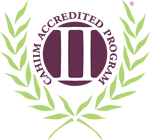Health Information Technology
- Associate Degree

Program Number:
Program Credits:
Estimated Total Cost:
Typical Start:
Health information technologists play a vital role in the healthcare sector by processing, storing, and exchanging health data within an electronic environment. As a Health Information Technologist (HIT), your responsibility is to safeguard health data, ensuring it is processed, delivered, and analyzed in compliance with state and Federal laws, such as HIPAA, while upholding confidentiality and security standards.
In our HIT program, you will delve into documentation practices, electronic health record laws and regulations, as well as the confidentiality and security of patient information. You'll learn how to maintain the integrity and accuracy of documentation within electronic health records, and gain proficiency in analyzing healthcare data, including mortality rates, census figures, and death rates, as well as the application of data to improve patient health outcomes. Coding is a fundamental aspect of effective documentation practices, and you will become skilled in identifying appropriate procedure and diagnosis codes to facilitate patient billing and uphold documentation standards, ensuring that bills are submitted correctly and accurately in accordance with federal and state laws.
As an HIT professional, you will become a member of the American Health Information Management Association, joining a community that provides the knowledge and resources needed to make a meaningful impact on healthcare while ensuring the accuracy and security of patient health data.
To view the Health Information Technology program’s required disclosure on professional licensure, please click here [1].
Health Information Technology 2021, 2022, & 2023 Graduation Employment Stats
| Graduates | 22 |
| Graduates Responding | 6 |
| Employed in Related Occupation | 4 |
| Employed in Non-related Occupations | 1 |
| Seeking Employment | 0 |
| Continuing Education | 0 |
| Not in Labor Market | 1 |
Salary Data - Related Employment
| Part Time | Full Time | |
|---|---|---|
| Responding | 1 | 2 |
| Average Hours Per Week | 33 | 40 |
| Average Hourly Wage | $21.00 | $21.50 |
| Hourly Wage Range | $21.00 | $21.50 |
| Average Annual Salary | $46,000 |
Respondents in Related Occupations
- Coding Specialist, Medical Coder, HIM Coordinator
Career Opportunities
Program Outcomes
- HIT - Apply data governance principles to ensure the quality of health data
- HIT - Apply coding and reimbursement systems
- HIT - Model professional behaviors and ethics
- HIT - Apply informatics and analytics in data use
- HIT - Apply organizational management techniques
Admission Requirements:
College Admissions Requirements
Application:
Application Fee:
Program Admissions Requirements
Transcript:
To enroll in the Health Information Technology program, first apply for admission to the College, then electronically sign the program's Technical Standards and complete a background check. You can find links to these documents below. Please see the details below.
- Health Information Technology Technical Standards [2]
- Background Check [3]
- If COVID vaccines are required by a clinical partner, you will be notified.
Software and Technology
Most of Western’s classes require the use of a personal computer or laptop, standard software, internet access, and other technology-related items.
If you do not have a personal computer or laptop, or if the one you have does not meet the following criteria, resources may be available. Submit a Student Resource Request using our online form [6].
Computer/Laptop Hardware
- Smartphones are not recommended for completing assignments.
- Chromebooks are not recommended due to issues with installing software that is needed for classes, such as Office 365.
- Web camera with microphone (usually built into newer laptops or can be purchased separately) is necessary for online participation.
Software Needs
- Western uses the Blackboard Learning Management System. Some courses may use Zoom or Microsoft Teams to meet and work virtually. Visit our website for guidance on how to access and use these tools [7].
- Office 365 (available to download for free once you have a student email)
- Recommended web browsers: Chrome or Firefox
For detailed specifications, please review Technology and Software Recommendations for Most Classes [8] on Western’s IT Knowledgebase.
Campus Resources
- Western has several computer labs available. Visit our website to find open hours and locations on the La Crosse campus [9]. Or find information on how to access resources on our Regional Locations web page [10].
- The Learning Commons has computers, webcams, and microphones available for in-house use. Our librarians recommend checking your local public library for computer access on the weekends. Staff members can also provide information on free, off-campus Wi-Fi spots. Contact them at LearningCommons@westerntc.edu [11] or call 608-785-9198.
Need Assistance?
- Contact the Learning Commons [12]! The staff are happy to answer questions, provide individualized assistance, and direct you to other supports as needed.
Accreditation
The Health Information Technology accreditor of Western Technical College is the Commission on Accreditation for Health Informatics and Information Management Education (CAHIIM). The College’s accreditation for Associate degree in Health Information Technology has been reaffirmed through 2028-29. All inquiries about the program’s accreditation status should be directed by mail to CAHIIM, 200 East Randolph Street, Suite 5100, Chicago, IL, 60601; by phone at (312) 235-3255; or by email at info@cahiim.org [13].

CAHIIM Reporting Requirements
Program Mission
The mission of the Health Information Technology Program at Western Technical College is to prepare students to become part of a credentialed workforce to support the needs of the health care industry.
Program Goals
The program’s goals reflect the principles and ethics of the Health Information field and support the College’s strategic goals which focus on recruitment, retention, student learning and satisfaction, financial stability and effectiveness of systems and processes. Target outcomes written for each goal are used to evaluate the program on an annual basis.
| Focus | Goal |
|---|---|
| Curriculum | The program’s mission and goals are outcome focused and relevant to the mission of the sponsoring educational institution. The program must assess the appropriateness and effectiveness of the curriculum with the results of program assessment used as the basis for ongoing planning and program improvement. |
| Students and Grads | The program will provide assurance that the educational needs of students are met and that graduates demonstrate at least the AHIMA entry level curriculum competencies. |
| Faculty Development | The program will provide a plan for faculty that establishes or assesses the knowledge, skills, qualifications and experience pertinent to the professional curriculum content that they are assigned to teach. This includes efforts to keep current in health information management and/or other relevant professional content and practice as well as other components of advanced formal education. |
| Communities of Practice Outreach | The program will respond at least on an annual basis to the needs of its communities of practice. The program will demonstrate how it serves as a source of continued education for the HIM professional community. |
| Advisory Committee | The Advisory Committee will assist program faculty and sponsoring educational institution personnel with the development and revision of program goals and curriculum, monitoring program needs and expectations and ensuring program responsiveness to change. |
National Accreditation Examination
Students who graduate from an accredited Health Information Technician program are eligible to take the national accreditation examination of the American Health Information Management Association (AHIMA). Earning the credential Registered Health Information Technician (RHIT) leads to increased salaries, career advancement and job mobility.
Recent examination results for Western’s Health Information Technology program graduates are as follows:
|
Western Candidate Summary
|
National Summary | ||
|---|---|---|---|
| Reporting Period | 1st Time Testers | Percentage Passing | Percentage Passing |
| January 2020-December 2020 | 1 | 100% | 69% |
| August 2020-July 2021 | 2 | 100% | Unknown |
| August 2021-July 2022 | 5 | 60% | 68% |
Graduate Employment Stats
Graduate follow up is conducted 6 months following graduation. Recent follow up data for Western’s Health Information Technology program graduates are as follows:
| 2020 | 2021 | 2022 | |
|---|---|---|---|
| Graduates Responding | 5 | 2 | 3 |
| Employed in Related Health Occupation | 3 | 2 | 2 |
| Employed in Non-related Health Occupation | 2 | 5 | 0 |
| Employment Rate | 100% | 100% | 67% |
Graduation Rate
Graduation rate is the percentage of first-time, first-year undergraduate students who complete their program within 150% of the published time for the program.
| Cohort Begin Year | 2017-2018 | 2018-2019 | 2019-2020 |
|---|---|---|---|
| Report Year | 2019-2020 | 2020-2021 | 2021-2022 |
| 3rd Year Graduation - Achieved Count | 7 | 4 | 5 |
| 3rd Year Graduation - Cohort Count | 19 | 17 | 15 |
| 3rd Year Graduation - % Graduated | 36.84% | 23.53% | 33.33% |
Student Satisfaction
Students are surveyed annually 6 months following graduation from the program. Survey questions include evaluation of the graduate's own knowledge base, clinical proficiency and behavioral skills following program completion, as well as an overall rating of the program. Ratings above the midpoint on a 1-5 scale are considered "satisfied".
2020: 4.6/5
2021: 5/5
2022: 4.7/5
Revised: March 2023
Additional Information
Our Health and Public Safety programs are required to report additional information to prospective students, including certification exams, licensure, program completion rates, etc. You can find this information in the document below:
Program Contact
Susan Summerfield
Program Chair, Health Information Technology
608-789-6103
SummerfieldS@westerntc.edu [15]
Career Pathways:
Health Information Technology
Prior Learning:
Previous education and work experience could qualify for Credit for Prior Learning, saving you time and money. Find out more [16] about what may apply to this program.
Technical Diploma:
Associate Degree:
Courses
Western offers most courses in a 7-week format, but course length can vary. There are two 7-week sessions in each term, so courses listed below may not be taken at the same time. See www.westerntc.edu/7-weeks [17] for more information.
This course list gives you an idea of what coursework will be required but is not the official list. Current students should use the MyWestern [18] self-service portal for academic planning.
